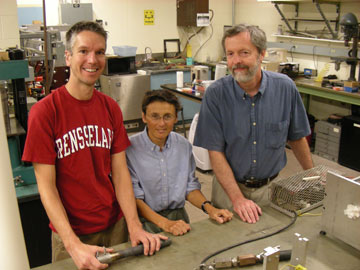|
NEWS NOTES
Geochemistry
Argonís gassy ride to the atmosphere
 Courtesy of Bruce Watson |
| A team of researchers, including from left to right, Jay Thomas, Daniele Cherniak and Bruce Watson, recently discovered that argon may not act as once thought on its way from the core-mantle boundary to the atmosphere. |
Deep beneath us, Earth is slowly stirring, hot rock tirelessly churns upward toward the surface and back down toward the core. When material nears the surface, part of it melts, while the rest continues to convect through the mantle. Gases deep inside the planet upwell with the materials and are believed to accumulate in the near-surface melt, from where they eventually escape the planet into the atmosphere.
Or at least that’s what researchers have thought. Scientists have long used the argon-40 isotope to measure the rate at which gas is released from deep in the Earth, but a new study indicates that the gas might behave differently. If correct, the new findings could throw into doubt current models of how Earth’s atmosphere formed.
Scientists have long thought of argon-40 as a prime candidate to study how Earth releases gases. Because the noble gas doesn’t react with other elements, it moves through the interior of our planet unchanged. Radioactive decay inside Earth is the only known source of argon-40, which means that all of it in today’s atmosphere must have come from deep below. Conventional wisdom also holds that individual argon atoms do not get trapped inside the crystal lattices of the upwelling mantle minerals. Therefore, they quickly diffuse into the melt and build up in the crust, from where they are released into the atmosphere. But new laboratory experiments, reported Sept. 20 in Nature, challenge this scenario.
Bruce Watson at Rensselaer Polytechnic Institute in Troy, N.Y., and his colleagues heated olivine and orthopyroxene — the two main minerals composing Earth’s mantle — in an argon atmosphere. The minerals entrapped unexpectedly large amounts of the gas. Moreover, once inside the crystals, the gas did not readily diffuse out of the minerals. “The results show that argon actually likes to sit in these minerals and that it would be difficult to get them out into the atmosphere during melting,” Watson says. “That means it’s time to rethink the mechanism by which our planet rids itself of gases.”
The findings have prompted mixed reactions among geoscientists. “This is an important study that shows us that Earth doesn’t quite work the way we thought it did,” says Michael Drake of the University of Arizona in Tucson. About 15 years ago, studies by Drake and colleagues showed results similar to Watson’s.
Others are not convinced. “Even though the science that Watson and his colleagues present is robust, the question is how relevant this laboratory study is to what really happens in the mantle,” cautions Chris Ballentine of the University of Manchester in the United Kingdom. He adds that conditions inside the mantle differ from those under which Watson and his team conducted their experiments. He also points out that calculations based on Earth’s budget of inert — or unreactive — gases agree with the traditional model of how argon escapes into the atmosphere. If Watson and his colleagues are right, however, and argon concentrations inside mantle minerals are much higher than previously thought, these numbers won’t add up, Ballentine says.
Watson recognizes that there is still uncertainty over these calculations, and he admits that there are other observations that “absolutely fly in the face of the new data.” For example, scientists who have examined rocks that contain cooled melt have discovered that most of the gas atoms are in the melt matrix rather than in the crystals. “This means that we have a real paradox here,” Watson says.
Which is correct remains to be seen, but in the meantime, the new work “gives us pause in our assumption and our knowledge of how Earth rids itself of gases and how you produce an atmosphere on a planet,” Watson says.

 Subscribe
Subscribe


